Your donation will support the student journalists of Rancocas Valley Regional High School. Your contribution will allow us to enter into regional and national competitions, and will help fund trips to journalism conferences to continue to improve our writing and work!
Holly Spirit Special Edition: the conflict in Ukraine
March 4, 2022
The increasingly-intense conflict in Ukraine has gained national and international attention. At RV, students, teachers and community members have been tuning in to nightly images of shelled-out apartment buildings and Russian tanks rolling down civilian roads. The stories of innocent men, women and children taking cover and lining up for aid are complimented by stories of courage, humanity and resilience.
The News team has been the entire week focusing on the Russian invasion of Ukraine, and this special edition is meant to catch students up to speed as well as provide a number of different perspectives and stories from the conflict.
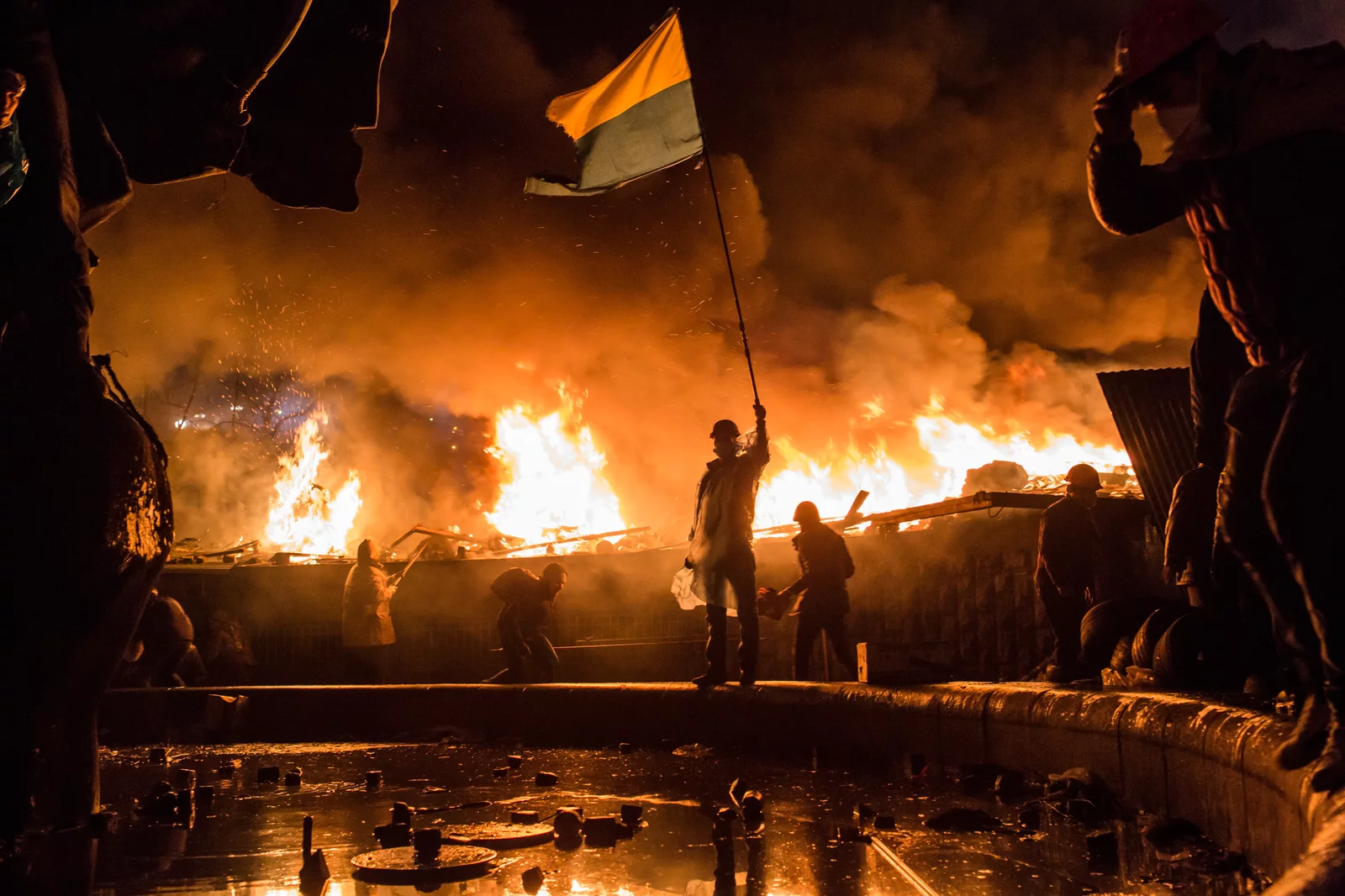
Anti-government protesters guard the perimeter of Independence Square, known as Maidan, in Kyiv on Feb. 19, 2014. Protesters were calling for the ouster of President Viktor Yanukovych over corruption and an abandoned trade agreement with the European Union.
How did we get here? A brief history of the Russian-Ukranian conflict
The two countries have been intertwined for decades
With growing tensions between Ukraine and Russia, knowing the complex history of the two countries is important in understanding why they are in a conflict now, especially as Russia continues to launch attacks on its former territory.
After Ukraine gained independence from what was then known as the Soviet Union on August 24, 1991, the newly founded country fought to join the North Atlantic Treaty Organization (NATO) but was met with resistance from the Soviet Union.
In December of 1994, the Soviet Union fell and Ukraine signed the Budapest Memorandum on Security Assurances to remove Russian nuclear weapons from their borders in exchange for “respect the independence and sovereignty and the existing borders of Ukraine.” from the United States, the United Kingdom and Russia.
According to “Radio Liberty,” “In return, Russia and the Western signatory countries essentially consecrated the sovereignty and territorial integrity of Ukraine as an independent state. They did so by applying the principles of territorial integrity and nonintervention in 1975 Helsinki Final Act — a Cold War-era treaty signed by 35 states including the Soviet Union — to an independent post-Soviet Ukraine.”
By the early 2000’s, Ukraine was working to improve upon its economic opportunities with President Leonid Kuchma spearheading the effort. Overshadowing the country’s strides towards progress, accusations of election rigging were launched, and Viktor Yanukovych, the candidate that Vladimir Putin, the president of Russia, supported ultimately won the election.
According to NPR, “[NATO] promised that Ukraine will one day be a member of the alliance but [did] not put it on a specific path for how to do so,” as Ukraine continued to fight for membership in the alliance. The potential of having a NATO nation on the border of Russia was widely seen a a threat to Russia’s rising autocratic power.
In February of 2014, the Maidan Revolution ensued after President Yanukovych refused to sign a European trade agreement and a series of violent protests occurred claiming the lives of countless protestors.
The new disapproval of Yanukovych led to his removal from office, and he left behind an interim Ukrainian government elected by Parliament. The shift of power from Yanukovych caused Russia to accuse Ukraine of staging an illegal coup, and Putin placed soldiers in the Crimean peninsula by March 2014.
Following Russia gaining control of Crimea, two regions, Donetsk and Luhansk, seceded from Ukraine and Russian troops continued to invade Ukrainian territory, particularly in Donbas where violence broke out. Roughly 13,000 Ukrainian civilians would be killed in the conflict.
According to NPR, “As fighting in the Donbas continue[d], Russia repeatedly [attacked] Ukraine in a series of cyberattacks, including a 2016 attack on Kyiv’s power grid that causes a major blackout. In 2017, a large-scale assault affects key Ukrainian infrastructure, including the National Bank of Ukraine and the country’s electrical grid.”
In late 2021, Putin began referring to what he called “special military operations” on the Ukrainian border, and send thousands of troops to conduct exercises throughout the month of February 2022. For months, Washington had actually warned of an impending invasion, which was later dismissed and even parodied in Russian media, which had amped up its anti-Ukrainian propaganda.
On February 24, Channel 1, a Russian state-controlled media outlet, announced an “historic moment.”
The announcer claimed that the residents of separatist-occupied eastern Ukraine were being subjected to “genocide” by Ukrainian forces, and that Russian military troops would be putting a stop to it.
According to NPR, “On Feb. 24, Russian forces launch[ed] a devastating assault on Ukrainian territory — the largest such military operation in Europe since the end of World War II.”
While the rest of the world condemned Russia’s aggression, Putin continued to defend the invasion, calling it a defense to against NATO-expansion, even claiming that Ukraine is not its own autonomous nation.
“Let me emphasize once again that Ukraine for us is not just a neighboring country,” Putin said on February 21. “It is an integral part of our own history, culture, spiritual space.”
Despite continued aggression — including Russian troops closing in on the captial, Kyiv — Ukrainian President Volodymyr Zelensky continues to encourage the Ukrainian people.
“If they [Russia] attack, if they try to take our county – our freedom, our lives, the lives of our children – we will be defending ourselves,” he said on February 22.
As of publication time, Russian forces recently took control of the Zaporizhzhia plant in southeastern Ukraine following an attack overnight, which caused a fire that led to widespread alarm throughout the region. Experts say that there has been no release of radioactive material. The attack continues as Russian troops move deeper throughout southeastern Ukraine. Zelensky has renewed calls for talks with Russia following the attack.
A brief timeline of key dates in the Russian-Ukrainian conflict
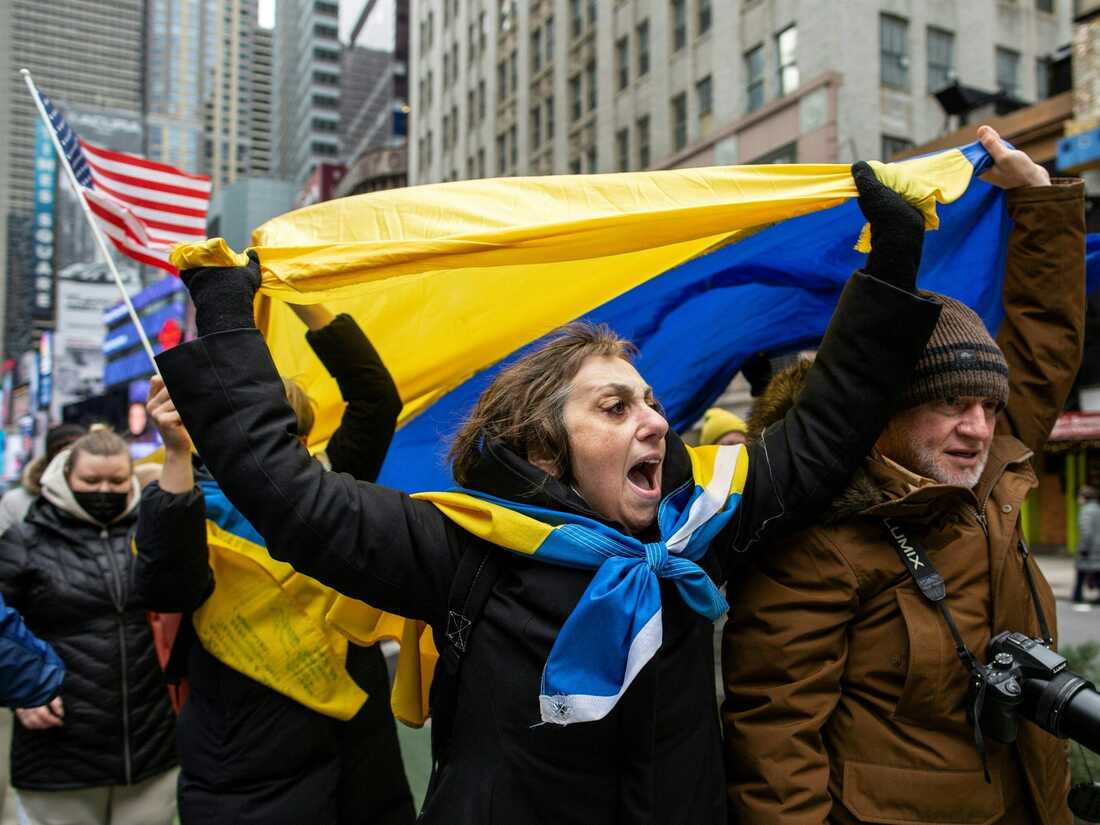
Photo courtesy of npr.org (AFP via Getty Images)
Demonstrators protest in support of Ukraine, in Times Square New York, on February 24.
Countries rush to help Ukraine in ongoing fight against Russia invaders
Over a dozen countries send assistance to Ukraine as the situation continues to escalate.
Countries like Poland, Germany, Portugal and the United States have all offered humanitarian and military aid to Ukraine and its citizens after Russian forces invaded last month.
When Russia launched an invasion of Ukraine, many civilians had to flee their homes. Neighboring countries like Poland and Moldova said they were willing to accept refugees and offer them help.
Borris Johnson, Prime Minister of the UK, said in an interview Saturday According to the BBC, “We’ve got to do everything we can to change the heavy odds that Ukraine faces and to help them.”
President Joe Biden has authorized $1 billion in military aid to Ukraine in just this year alone, according to the LA Times.
“Many other countries are contributing to Ukraine’s ability to defend itself from the unprovoked Russian aggression,’’ said John Kirby, a Pentagon official. ‘’We, along with our allies and partners, are standing together to continue to expedite security assistance to Ukraine,” Kirby said, adding that Washington’s pledges signified its “unwavering support for Ukraine’s sovereignty and territorial integrity.”
According to Defense News, countries such as Italy, Sweden and Norway have all donated weapons to the Ukrainian military. Things like armored vehicles, assault rifles, rocket launchers and even missiles have been sent in order to combat the Russian onslaught.
“This is an important response that gives a sign of the concrete solidarity for Ukraine,” said Italian Defense Minister, Lorenzo Guerini. “Whoever wanted to divide us has been disappointed.’’
However, some other countries have decided to back Russia in this ongoing conflict. Belarus, Syria, and Cuba have all expressed support for Russian President Vladimir Putin’s invasion of Ukraine.
According to the Philadelphia Inquirer, Belarusian troops may be sent in to help conquer Kyiv and Belarus may be a new base for storing nuclear weapons.
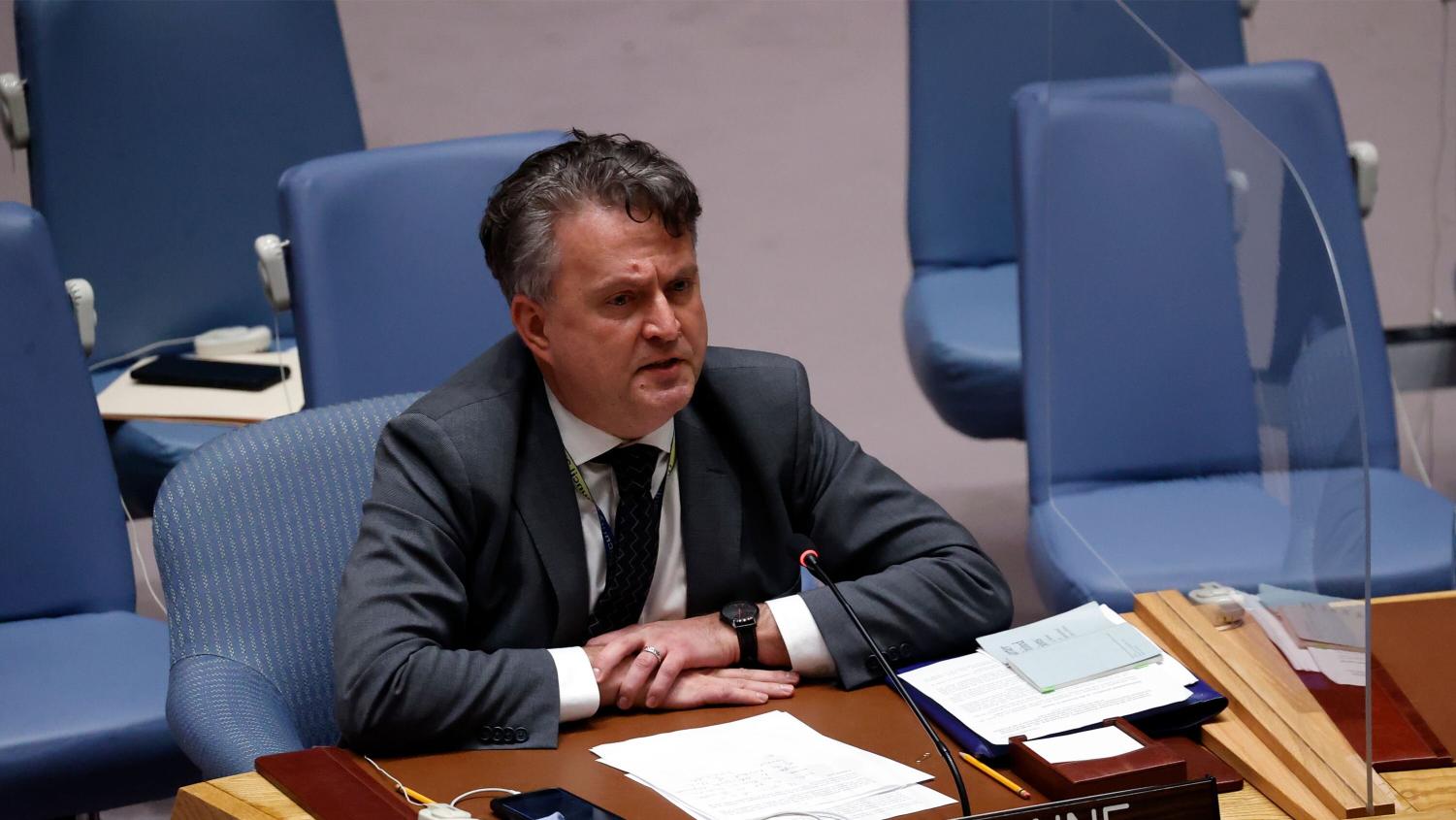
Ukraine’s ambassador to the UN on March 2
UN condemns Russian invasion; expresses support for Ukraine
The meeting on March 2 resulted in a resolution calling for the immediate withdrawal of Russian troops and a ceasefire
Ukraine and Russia ended attempts at a diplomatic end to the conflict after a five hour long delegation on February 28. After neither side yielded, the hope for a peaceful solution has dissolved.
March 1st’s UN assembly meeting saw over 100 diplomats leave the hall during a pre-recorded speech by Russian Foreign Minister Sergei Lavrov. Diplomats who were involved in the boycott include those from the European Union, the United States, the United Kingdom and Japan.
The speech included the foreign minister claiming Ukraine was violating the human rights of Russo-Ukrainians in the East Ukranian Donbas region and the laws Ukraine is passing are similar to those of Nazi Germany. There is no evidence to support any of these claims.
The UN Assembly, during an emergency session on March 2, voted on the course of action following Russia’s invasion. In a 141-5 resolution, the assembly called for immediate withdrawal of Russian forces from Ukrainian territory, and a ceasefire. And while it is not legally required that Russia follows the resolution of the General Assembly, it puts pressure on it and its ally, Belarus.
Belarus is one of Russia’s most significant allies in both politics and economics. Its land is open to use by Russia to store nuclear weapons, and Belarusian troops could be used alongside the Russian army as of February 25th.
As reported by ABC News, Cuban ambassador Pedro Luis Cuesta blamed “U.S. determination to keep expanding NATO towards Russia’s borders,” for Russia’s invasion of Ukraine. Cuesta abstained from voting during the March 2 UN meeting, along with 34 other countries.
The only four countries who voted in support of Russia in the March 2’s assembly were Belarus, North Korea, Eritrea, and Syria. China, Russia’s ally, abstained from voting, as did India, Iraq, and Iran.
Belarus’s President, Alexander Lukashenko, has garnered criticism from both his people and other nations for providing Putin aid. India’s abstaining comes as a shock, as Russia has supported India on several issues and has provided them with military equipment.
President Biden has expressed the intention to continue supporting Ukraine. However, Russia has warned that American or NATO interference in Ukraine would be crossing a “red line.”
The leaders of the “Group of Seven” (U.S.A, Canada, E.U, France, U.K, Italy and Japan) have agreed to stagnate Russia’s economy by cutting off their access to American banks and any asset or investment it has in America. The intention is to disable Russian forces both internally and in Ukraine.
A map of impacted areas of Ukraine
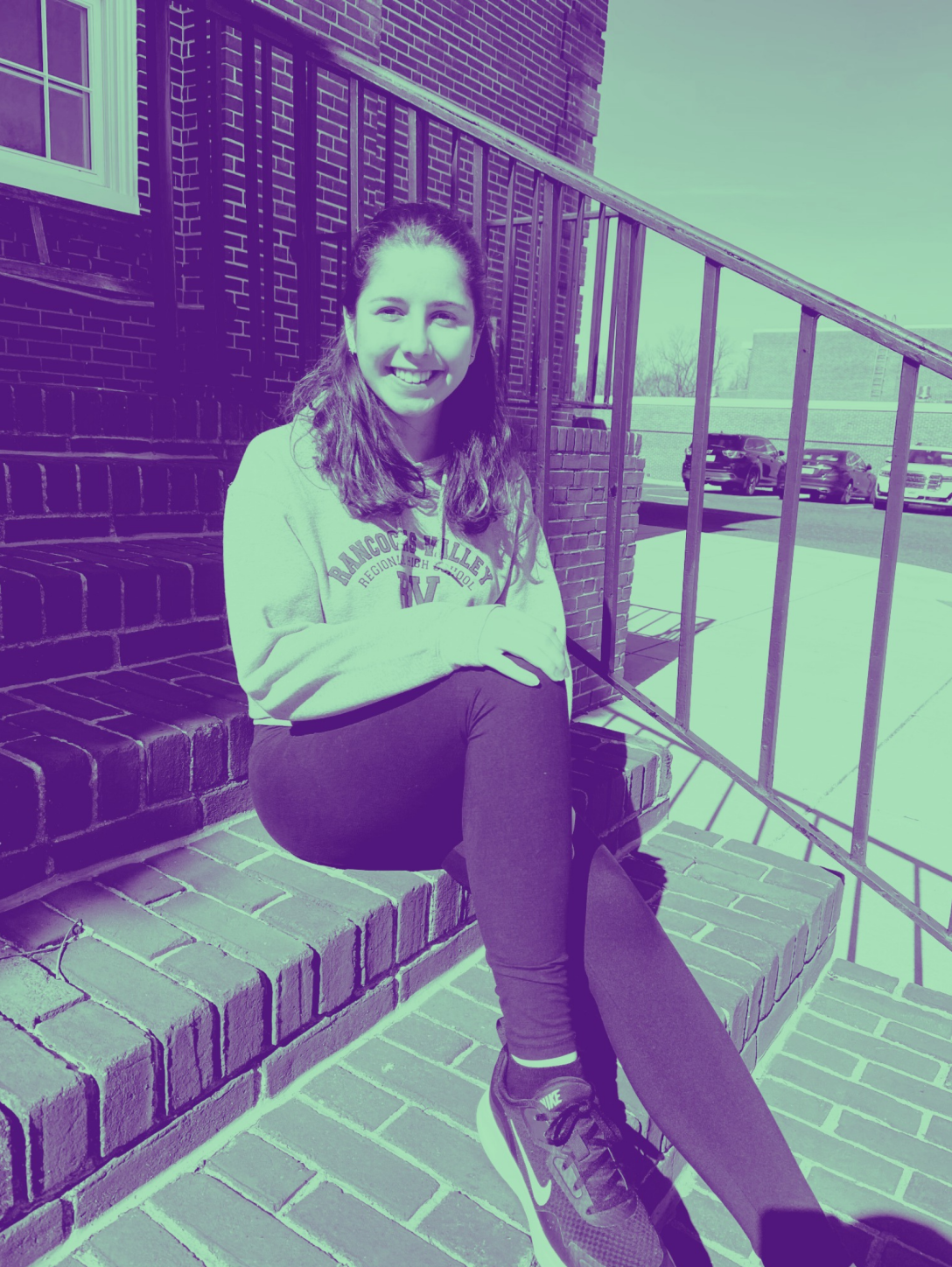
Photo courtesy of Jya Marshall
“The war is destroying my country”: voices from Ukrainian community members
Ukrainian students and staff discuss their perspectives towards the conflict
For many students and staff at RV, the sites and news coming out of Ukraine have been jarring. Images of children huddled in subways with their parents, long lines of families waiting for food or fuel and descriptions of bombings in neighborhoods have emphasized the trauma and chaos of the Russian invasion of Ukraine last month.
For some, however, the invasion hits home in a very personal way.
Junior Jazmin King is the daughter of Viktoriya Shylina, a Ukrainian immigrant who came to New Jersey with members of her family when she was 14. Shylina’s father still lives in Ukraine along with several aunts and uncles, and her grandmother. She is from Chernivtsi, a city in southwestern Ukraine, and according to King, her attention has been devoted to news coverage of the conflict.
“[My mother] has been talking to my great grandmother, who had a stroke recently from the stress of the conflict,” said King. “She has also been talking to aunts, and I’ve even talked to a cousin for the first time ever. My aunt and cousin are in their homes, but I am unsure of where my grandmother is.”
King describes a difficult scene for her mother, who has been glued to the TV morning and night to get information about the invasion.
“I’ll come home, and it’s clear that she’s been crying,” she said. “The news is on 24/7…the first thing [my mother] does when she wakes up is turn on the news. Sometimes I’ll wake up in the middle of the night and she’s up listening to the news.”
Prior to immigrating to America, Shylina grew up in a Ukraine that was always in the shadow of Russia. The country gained its independence in 1991 when the Soviet Union was terminated, but for decades after the tension on the border of Russia has resulted in more and more posturing from Russia. King says that Shylina “hates” Putin.
“She says he’s like Grendel from ‘Beowulf,'” said King, who is reading the Anglo-Saxon text in her English class.
King’s mother calls the fighting “unnecessary” and points to the interconnectedness of Russian and Ukrainian identity throughout history.
“[Ukrainians and Russians] are all one, we all stemmed from Russia,” said King of her mother’s perspective on the tensions. “It’s unfair that thousands of innocent [individuals] are fighting for their lives. We were actually planning on going to Ukraine in the summer.”
Thankfully, much of King’s family is on the western border of the country, about 30 miles from the Romanian border. However, King is unsure of whether or not they will remain in the country, especially since (at the moment) they are far from the fighting.
More than anything, King said her mother wants help for her country.
“She wants the U.S. to step in,” she said. “She thinks the invasion is going to lead to something a lot worse. It’s not going to stop…my mom is even worried about the pets. She feels like if food runs out, [Ukrainian people] may have to resort to eating their pets. Food is a very big issue right now.”
King also pointed to her mother’s growing frustration in both indifference and empty promises towards the people of Ukraine. While there is overwhelming support for Ukraine and worldwide condemnation of Putin’s aggression, King said that Shylina continues to get exasperated with the lack of U.S. military intervention. During his State of the Union address on Tuesday, Biden spoke to the join session about the conflict with Ukraine, but King said that her mother felt that it wasn’t enough.
“His speech was more about domestic issues and what he was going to do for America rather than Ukraine,” she said.
Despite this, King said she does feel like many students at RV are aware of the conflict and are willing to talk about it.
“Especially in history classes,” she said. “I feel like teachers are trying to keep everyone up to date [with the conflict].”
When asked if there is anything she wants her peers to know about the conflict, King paused. “That’s a difficult question,” she said. “I really don’t know.”
The ambivalence that King expressed towards the conflict was echoed by Ms. Natasha Campanella, one of the cafeteria staff, who is Ukrainian. Donning her “Proud to be a Ukrainian” pin as she staffed the snack line at lunch Campanella repeated many of the same sentiments as King’s mother towards the Russian invasion.
“No one expected the war to happen,” she said. “It’s not worth people dying every day.”
Campanella said that she feels “incredibly frustrated and upset,” and that, according to her, the war doesn’t make sense. Though she recently got married, she still has family in Ukraine.
“The war is destroying my country,” Campanella said. Despite this, she continues to be “proud” to be Ukrainian.
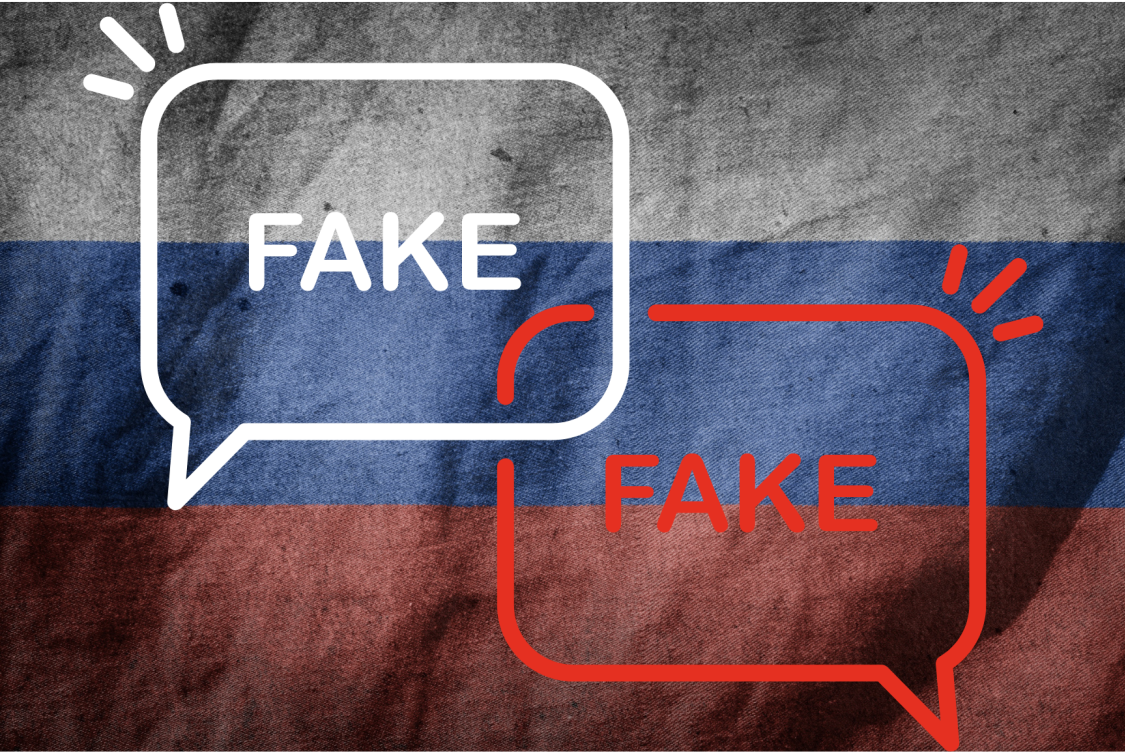
Misinformation on Russia-Ukraine conflict creates challenges in getting narrative right
Russian and American political propaganda have flooded social media
As the Russia-Ukraine conflict escalates, social media posts consisting of propaganda and misinformation are becoming commonplace.
When seeking information on the Russia and Ukraine War, be cautious of what media you are using. With the flow of information from source to source on a topic, reality can be botched and some media outlets end up producing false facts. Media propaganda has long been utilized as a control tactic by the Russian government, otherwise known as the Kremlin, which furthermore facilitates what media can reach Russian citizens.
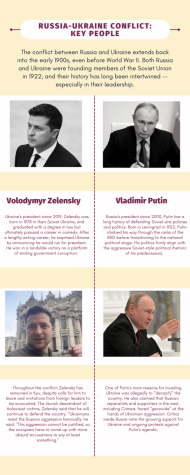
Russian troops, under direction of President Vladimir Putin, invaded Ukraine approximately two weeks ago, and since then the Russian government has increased the volume of national propaganda about the conflict. Russia has continuously spread the narrative that the majority of Ukraine and its citizens are aggressive and seek to undermine the Russian government.
“[The] goal is to protect people who have been abused by the genocide of the Kyiv regime for eight years,” Putin stated in his speech last week explaining Russia’s military offense on Ukraine. “And to this end, we will strive for the demilitarization and denazification of Ukraine, as well as bringing to justice those who committed numerous bloody crimes against civilians, including citizens of the Russian Federation.”
This was Putin’s attempt at justifying his actions, as he believes Ukraine is rightfully Russian territory and that Ukraine’s government is illegitimate and anti-Russian. The Russian President went on to say that his military will not “impose anything on anyone by force,” despite footage of rocket strikes and 40-mile long stretches of tanks outside Ukraine’s capital being present. Missile strikes continue into each day, and despite Putin’s claims that Ukriane is the aggressor, Russian bombs have flattened Ukrainian buildings, including a government building in central Kharkiv.
There is no question that Putin and the Kremlin are manipulating the media in an attempt to maintain support from the Russian population. Russia’s government is trying to limit such aforementioned footage from getting to citizens of Russia. The Kremlin has told all independent Russian media outlets to only receive their informational reports on Ukraine from the Russian government itself, and to not use words such as “invasion, attack [or] war.” If these media outlets release any unwanted information on the war, the Kremlin has threatened to shut them down.
Furthermore, the Kremlin has limited Russian citizen’s access to social media applications such as Meta (and Facebook), Instagram and TikTok.
Ukraine’s government had advised social media companies to shut down completely in Russia, but like other companies, Meta disagrees.
“In the long run, the thing that really undermines propaganda is counter speech,” stated Nick Clegg, president of global affairs at Meta.
Popular social media outlets such as YouTube and Facebook are blocking two of Russia’s largest outlets, RT and Sputnik News, across Europe in order to decrease the spread of propaganda about the Russian invasion. According to The Washington Post, Ukrainian cybersecurity experts have launched online hacking apps and are crashing Russian outlets that spread any dangerous disinformation.
Ukrainian activist and analyst Liuba Tsbulska, who has been tracking Russian disinformation for nearly a decade, told The Washington Post, “We have two types of warriors. First, military warriors, those who defend us physically. And we have information warriors, those who fight against Russian disinformation, Russian special forces psychological information operations and so on.”
Second guess vivid videos being released with explosions and militias as they may not be from the current conflict in Ukraine. A video of a soldier parachuting through the sky has gained viral attention on the social media app TikTok, but even this footage is at least five years old.
As war rages in Ukraine, Russia continuously pushes out misinformation about the war and Ukraine. It is important to research extensively when trying to find factual information on this war and about any news topic in general.
Uncertainty dominates RV student perspectives on conflict in Ukraine
While most sympathize with Ukraine, many are concerned about military intervention
So far, the Russian invasion of Ukraine has allegedly led to the deaths of over 2,000 Ukrainian civilians, a million refugees fleeing the country and much more statistics of suffering. NATO (the North Atlantic Treaty Organization) members have all condemned the invasion and have put brutal economic sanctions on Russia. These sanctions have cut off the Russian economy from the rest of the world and have made the Russian Ruble largely worthless. Anti-war protests have erupted all over Russia and the world. Many point to the notion that the world hasn’t been this close to a world war in decades.
Most students at RV are aware of the conflict and are watching news coverage about the invasion. Many students defend Ukrainians arming themselves to defend their homeland, and many believe that Putin’s invasion of the country was without warrant.
”I think Ukraine is in the right,” said junior Brianna Mascali. “Russia is just attacking them because they want to form an alliance with other countries that will protect them.”
“I feel like NATO should get involved [militarily]” said sophomore Ryan Trojanowsky. Junior Anjali Darji agreed, and noted that it should intervene, perhaps through sending troops of weapons.
Other students demonstrated uncertainty about larger-scale military involvement.
Junior Nyla Tanim was unsure, and said that if Biden sent troops, it could “cause something more what we are doing within only Russia. I don’t want that happen over here.”
To complicate matters, the recent capturing of a nuclear site in southern Ukraine has raised the alarm of some students. Some believe that Putin would be the type of leader to demonstrate strength through nuclear arms.
“Where does [Putin] want to go [after Ukraine]?” asked Mascali. “Does he want to attack more countries?”
Mascali pointed to similarities between the Russian invasion of Ukraine and the German invasion of Poland in 1939, which began WWII.
After invading Poland, “Hitler continued on, and everyone looked away until it became a problem,” said Mascali.
Despite differences in perspectives, most students and teachers have taken the time to educate themselves on the conflict and continue to watch the news coming out of eastern Europe.
The ghost of Kyiv
The unverified “ace” of the Ukrainian airforce is becoming a national hero
Following Russia’s invasion of Ukraine on February 24, an unidentified Ukrainian fighter pilot in an MiG-29 is being credited with shooting down six Russian planes. Whether confirmed or not, the rumor is proving to be a boost of morale for Ukrainian forces.
The claims of the ace pilot (a pilot who scores five or more kills) are unverified, spreading rapidly via social media platforms. Task and Purpose reports that the first mention of the Ghost of Kyiv is “in a series of three tweets showing a lone Ukrainian fighter jet operating over the capital.” These tweets have since become viral on twitter, bringing fame to the mystery pilot with word spreading quicker by false reports of Ghost of Kyiv sightings with false video footage.
Ukraine displayed their enthusiasm with their acclaimed avation hero in a Twitter post on the country’s Twitter page saying “People call him the Ghost of Kyiv. And rightly so — this UAF ace dominates the skies over our capital and country, and has already become a nightmare for invading Russian aircrafts.” The message was accompanied by an animated clip of the pilot in action in his MiG-29 fighter jet.
Although the hearsay is encouraging, “a senior U.S. defense official told reporters on Friday that Russia had not yet achieved air superiority, and that Ukrainians ‘still have air and missile defense capability, including aircraft … in the air that continue to engage and deny air access to Russian aircraft.’ This makes the possibility of a sole air ace out of Ukraine’s potentially 98-strong fleet of combat aircraft highly unlikely.”
The mystery of the Ghost of Kyiv remains unconfirmed with many posts on social media regarding the pilot to be fake. But, Ukraine remains hopeful: “Dozens of experienced military pilots, from captain to general, previously released from the reserve, are returning to the Air Force. Who knows, maybe one of them is the pilot of the MiG-29, which is so often seen by the people of Kyiv!”, posted by the Ukraine Defense Ministry on Twitter.
